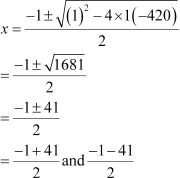Conditions Under which a Quadratic Equation has Real or Imaginary Roots
A right angled ΔABC is given in the following figure.

In this triangle, the base BC is 5 cm less than twice its height AB. The hypotenuse of the triangle is 2 cm.
Is the above given situation possible for triangle ΔABC?
Can we also find the nature of roots of a quadratic equation without solving the equation?
We can see from the above example that the value of x depends on the value under the sign of square root. If this value is positive, then the value of x will be real and if it is negative, the value of x will be imaginary.
Thus, we can say that the nature of the values of x in quadratic equation ax2 + bx + c = 0, depends on the value of b2 − 4ac.
Here, b2 − 4ac is called the discriminant of the quadratic equation ax2 + bx + c = 0. The value of b2 − 4ac determines the nature of the roots of a quadratic equation.

For example: The quadratic equation 3x2 − x + 2 = 0 has no real root because for this equation,
b2 − 4ac = (−1)2 − 4 × 3 × 2
= 1 − 24
= − 23 < 0
Here b2 − 4ac < 0.
Thus, the equation 3x2 − x + 2 = 0 has no real roots.
Now, let us solve some more examples based on the natures of roots of quadratic equations.
Example 1: Find the value of discriminant for the quadratic equation x2 + 4x − 21 = 0.
Solution:
The given quadratic equation is x2 + 4x − 21 = 0.
On comparing this equation with the standard form of quadratic equation, ax2 + bx + c = 0,
we have
a = 1, b = 4, c = − 21
Therefore, the discriminant, b2 − 4ac = (4)2 − 4 × 1 × (− 21)
= 16 + 84
= 100
Thus, the value of discriminant for the given quadratic equation is 100.
Example 2: Find the nature of the roots of quadratic equation, x2 − 8x + 16 = 0.
Solution:
The given equation is x2 − 8x + 16 = 0.
On comparing this equation with the standard form of quadratic equation, ax2 + bx + c = 0, we have a = 1, b = − 8, c = 16.
Therefore, the discriminant,
b2 − 4ac = (− 8)2 − 4 × 1 × 16
⇒ b2 − 4ac = 64 − 64
⇒ b2 − 4ac = 0
Thus, the given quadratic equation has two equal real roots.
Example 3: Find the value of k for which the quadratic equation x2 − 12x + k = 0 has two real equal roots.
Solution:
On comparing the given equation with ax2 + bx + c = 0, we have a = 1, b = − 12, c = k
For two real equal roots,
b2 − 4ac = 0
⇒ (− 12)2 − 4 × 1 × k = 0
⇒ 144 − 4k = 0
⇒ 4k = 144
⇒ k = 36
Thus, the value of k is 36.
Example 4: Is it possible to design a rectangular garden whose area is 250 square m and the sum of whose length and breadth is 20 m?
Solution:
Let the length of the garden be x m.
∴ Breadth = (20 − x) m
Area of garden = length × breadth
250 = x × (20 − x)
⇒ 250 = 20x − x2
⇒ x2 − 20x + 250 = 0
This is a quadratic equation whose discriminant is b2 − 4ac = (− 20)2 − 4 × 1 × 250
= 400 − 1000
= − 600 < 0
Therefore, the roots of the equation are not real. Hence, it is not possible to design such a garden.
Example 5: Can we find two consecutive positive numbers whose product is 420? If yes, then find the numbers.
Solution:
Let one number be x.
Then the other number = x + 1
According to the question,
x × (x + 1) = 420
⇒ x2 + x = 420
⇒ x2 + x − 420 = 0
The discriminant of this equation is b2 − 4ac = (1)2 − 4 × 1 × (− 420)
= 1 + 1680
= 1681
∴ b2 − 4ac > 0
Therefore, the roots of the quadratic equation x2 + x − 420 = 0 are real. We can find the numbers using quadratic formula as follows

x = 20 and − 21
We take x = 20, as − 21 is a negative number.
Thus, 20 and 21 are the two consecutive positive numbers whose product is 420.

 SonikaAnandAcademy
SonikaAnandAcademy
 ACERISE INDIA
ACERISE INDIA
